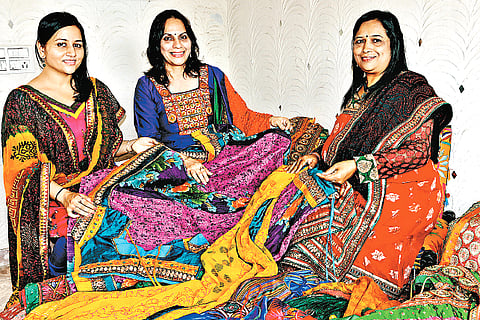

Come October and the atmosphere in Gujarat is filled with the excitement of nine nights—Sharad Navratri festival. Men and women dressed in traditional attires paint the state in bright colours. Jagruti Shah’s year-long efforts bear fruit during this time. Jagruti is an entrepreneur, designing and making elaborate chaniya choli and other traditional attires, worn during the Navratri festival under the banner Jainam Handicrafts and Jagruti Exports.
Chaniya choli also called lehenga choli or ghaghara choli is a three piece set for woman comprising a heavily gathered skirt called chaniya, a midriff baring blouse called choli and odhni, a veil clothe. Jagruti’s chaniya cholis are embellished with block prints, embroidery, mirrorwork, appliqué, brocade, shells and other surface ornamentation. The kediyus, which are jackets or vests worn by male dancers, are also lavishly embellished. It is not easy to sustain a business with just one set of products, mostly used during a particular festival. Jagruti says, “I realised that there was a niche market of consumers that was willing to buy quality chaniya choli sets but had reservations since it was worn for only nine nights, this made them opt for cheaper dresses or hire expensive ones on rent.”
Most of the cholis available in the 1980s and early ’90s were of free size and did not give a perfect fit. Jagruti says, “I started making choli with an overlapping fabric that could be fastened at any level according to the wearer’s size. This way the dress was more comfortable and could be kept for the following years because the size did not matter. As the business improved, I was soon on the way from being a homemaker doing some work on the side for a second household income to becoming a full-time entrepreneur.’’ Jagruti adds, “Coming from a modest family, I grew up watching my mother make garments for a living. After marriage, I started taking orders for salwar kameez which I sub-contracted to tailors. In 1989, I started making a few chaniya cholis.’’
It was only in 1998 that the business really boomed. “Until then I had depended on a few dealers but by then the word had spread about our work, after that retailers, even direct customers, started coming to the workshop to place their orders,’’ says Jagruti. “A factor that worked in my favour was the growing popularity of garba and dandiya nights overseas. Across US, UK, parts of Africa, the middle-east and even South-East Asia, Gujarati associations organise Navratri celebrations that attract thousands of participants. Non-resident Gujaratis during their visits to home, buy the attires for these community celebrations in their respective countries. For them, I make a special light-weight chaniya choli, which is easy to carry, keeping in mind the baggage weight restrictions.’’
From 2000-2001, Jagruti began to get orders from places with a large Gujarati diaspora like New Jersey, Atlanta, Chicago, London, etc. “Most dealers and retailers from overseas come to India in summer to place their orders for the Janmashtami, Raksha Bandhan, Ganpathi, Navratri, Durga Puja, Diwali festival products. During the holidays from Fall through Christmas to Easter in western countries, Ahmedabad experiences what is called the ‘NRI season’ with Gujaratis from US and UK flocking to the city. Another reason for the growing demand for chaniya cholis, according to Jagruti, is that Gujarati families in India and overseas include garba and dandiya raas nights in their wedding celebrations. Special chaniya cholis in white with embroideries are worn during the Sharad Poornima full moon celebrations of Gujarati communities.’’
Jagruti gets fabrics from silk weavers in Bangalore, Mysore and Varanasi, and also mill-made cottons and poplins for less expensive dresses. The fabrics are embellished by artisans in Gujarat and Rajasthan. The chaniya cholis are then stitched by home workers and tailors according to her sketches. “A blend of tradition with some trendy touches is popular with the younger generation, which is getting bolder in their choice of cuts, low or V necklines, halter necks for cholis. The back could be solid or cut-out. Crushed cotton skirts have also become popular,’’ she says. “Apart from jamawar, embroidery, block prints, beadwork and other traditional handiwork, hanging beads or silver embellishments are also sometimes in demand. Dresses in the range of `550 to `6000 are popular, expensive dresses which runs in tens of thousands are usually bought by professional performers. The dresses for the performing groups and serious enthusiasts in Gujarat are made of rich silk and beautifully embellished.’’
With her business doing well, Jagruti’s husband has retired from his bank job, and together with her son, Jainam, has also joined the business. “My daughter too helps in the store. All this has encouraged me to expand. We started the business from the front room of our house and today we have moved to our corporate house that we built from scratch. Besides the garments, we sell all the requisite accessories like ornaments and the dandiya sticks. Over the years, I would like to bring in more innovations into the Chaniya Cholis,” signs off Jagruti.